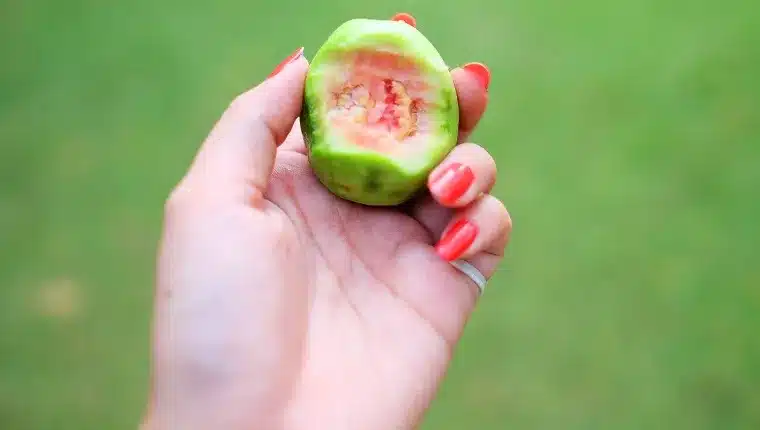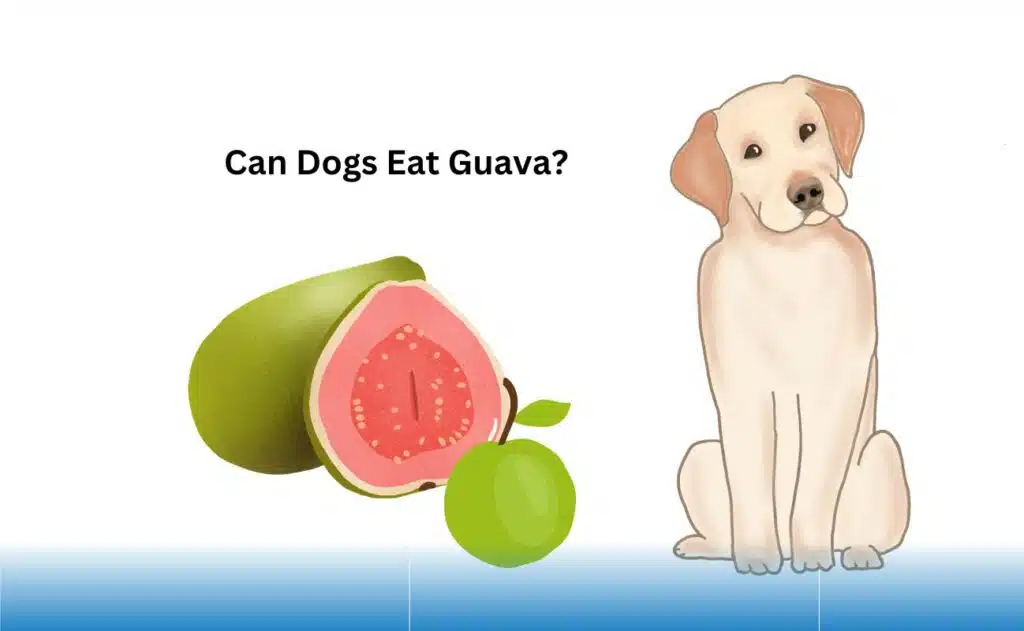Can Dogs Eat Guava? When it comes to our furry friends, we always want what’s best for them, especially in terms of nutrition. Dogs, much like humans, require a balanced diet enriched with nutrients to maintain their health and vitality.
Table of Contents
Can Dogs Eat Guava? While we often think of meat and kibble as staple components of a dog’s diet, fruits can also play a significant role. They are refreshing treats and can be a source of essential vitamins and minerals.
However, not all fruits are created equal in the eyes of canine nutrition. This brings us to the tropical delight known as guava. It’s sweet, it’s juicy, and it’s packed with nutrients, but the question remains: Can dogs eat guava? In this blog post, we’ll peel back the layers of this question, exploring the benefits and risks of feeding guava to dogs, and provide you with all the information you need to make an informed decision.
Can Dogs Eat Guava?

Guava is not only safe for dogs to eat but can also be a healthy addition to their diet. This fruit is a powerhouse of nutritional value, boasting high levels of vitamin C, vitamin A, fiber, and antioxidants. These nutrients can bolster a dog’s immune system, improve skin health, and even aid digestion.
Despite its benefits, some pet owners have reservations about introducing guava into their dog’s diet. Concerns often stem from the fear of toxicity or allergic reactions. Rest assured, guava is non-toxic to dogs, and allergies are rare. However, it’s crucial to introduce any new food gradually and observe your dog’s reaction.
Benefits of Guava for Dogs
The nutritional profile of guavas is one of the most impressive of all fruits. In addition to being high in vitamins C and A, it also has antioxidant properties that promote the body’s immunity and vision. Guava is rich in dietary fiber that promotes intestinal health, while its antioxidants assist in the fight against free radicals, potentially reducing the risk of chronic diseases as well.
Also Read: Is Rawhide Treat Bad For Your Dog? A Deep Dive from an Experienced Dog Owner
These nutrients don’t just contribute to a dog’s health on paper; they translate into tangible benefits. For instance, the vitamin C in guava can be particularly beneficial for older dogs or those with weakened immune systems. The fiber aids in smooth digestion, and the antioxidants can contribute to a shiny coat and healthy skin.
How to Safely Feed Guava to Dogs

If you’re convinced about the benefits and ready to treat your dog to some guava, here’s how to do it safely:
- Moderation is key. Start with small amounts to ensure your dog doesn’t have an adverse reaction.
- Remove the seeds. While not toxic, they can be a choking hazard or cause intestinal blockage.
- Peel the skin. Some dogs might find it hard to digest.
- Serving size matters. A slice or two of guava is enough for a dog, depending on its size and dietary needs.
Guava Recipes for Dogs
Want to get creative with guava for your dog? Here are some simple recipes:
Guava Cubes: A Chilled Canine Snack
Guava cubes are an excellent way to provide a refreshing and hydrating treat for your dog, especially on hot days. Here’s how to make them even more appealing:
- Select ripe guavas that are soft to the touch. Ensure they’re free from blemishes or soft spots.
- Wash the guava thoroughly under running water to remove any dirt or pesticides.
- Cut the guava into halves and scoop out the seeds, as they can be a choking hazard.
- Puree the guava flesh until smooth. You can add a little water if necessary to get a pourable consistency.
- Pour the puree into an ice cube tray, filling each section halfway to create bite-sized treats.
- Freeze for several hours until solid. Once frozen, pop out a cube and let your dog enjoy the cool treat under supervision.
Guava Smoothie: A Creamy Canine Concoction
For a more indulgent treat, a guava smoothie can be a delightful snack for your dog. Here’s a recipe that’s both delicious and nutritious:
- Prepare the guava by following the same initial steps as for the guava cubes.
- Blend the guava flesh with a spoonful of plain, unsweetened yogurt. Yogurt is a good source of calcium and probiotics, but make sure it doesn’t contain xylitol or artificial sweeteners, which are harmful to dogs.
- Add a drizzle of honey for a touch of natural sweetness. Remember, honey should be given in moderation due to its high sugar content.
- Blend until smooth, adding a little water if needed to reach the desired consistency.
- Serve immediately in a dog-friendly dish, allowing your pet to lap up this tropical treat.
Additional Guava Treat Ideas:
- Guava Jerky: Thinly slice guava and dehydrate the pieces in an oven at a low temperature until they become chewy. This can be a great alternative to store-bought chews.
- Guava Popsicles: Mix guava puree with a little chicken broth and freeze in popsicle molds for a savory-sweet treat.
Safety Tips:
- Always introduce new foods gradually to your dog’s diet to avoid digestive upset.
- Monitor your dog for any signs of allergies or intolerance.
- Consult with your veterinarian before making significant changes to your dog’s diet, especially if they have health issues.
These guava-based recipes are not only a great way to spoil your dog with something special, but they are also an excellent way to introduce healthy fruits into their diet as well. If you follow these tips, you can ensure that your dog is able to enjoy the many benefits of guava in a fun and safe way.
Potential Risks and Considerations
While guava is generally safe, there are a few things to keep in mind:
- Allergies: Though uncommon, monitor your dog for any signs of an allergic reaction.
- Digestive issues: Overfeeding guava can lead to diarrhea or stomach upset.
Case Study: The Digestible Truth About Guava Fiber in Canine Diets
In the quest to understand the impact of guava on dogs, a fascinating case study presents itself. This study delves into the use of guava fiber, alongside sugarcane fiber and wheat bran, as ingredients in dog food. The findings offer a wealth of insights that support the inclusion of guava in a dog’s diet, not just as a fruit but as a functional fiber source.
The Science of Guava Fiber
The study observed that guava fiber, when added to dog food, increased the dough’s resistance to flow. This resulted in a higher specific mechanical energy requirement during the production of kibbles. The fibers also affected the macrostructure of the extrudate, creating denser and harder kibbles. This is particularly interesting because it suggests that guava fiber can enhance the textural quality of dog food, which may have implications for dogs’ dental health.
Moreover, fibers were found to potentially reduce starch cooking during the extrusion process. However, when fibers with smaller particle sizes were used, there was a notable increase in kibble expansion and starch gelatinization. This indicates that the size of the fiber particles plays a crucial role in the final product’s quality.
Guava Fiber in Action
The practical application of this study involved formulating four different diets for adult Beagle dogs, varying the inclusion levels of guava fiber. The diets were:
- CO: Control diet with no fibrous ingredients.
- GF3: Diet with 3% guava fiber.
- GF6: Diet with 6% guava fiber.
- GF12: Diet with 12% guava fiber.
The guava fiber replaced maize in the diets, with adjustments made to maintain consistent protein and fat levels. Over a period of 30 days, the dogs’ nutrient digestibility, fecal characteristics, fermentation products, gastrointestinal transit time, and palatability were meticulously monitored.
Findings and Implications
The addition of guava fiber did not alter the overall nutrient intake, except for an increase in dietary fiber. Interestingly, as the level of guava fiber increased, there was a quadratic reduction in the total tract apparent digestibility for dry matter, organic matter, crude protein, and crude energy. This suggests that while guava fiber is beneficial, there is an optimal amount that maximizes its advantages without compromising nutrient absorption.
The study also revealed that higher levels of guava fiber did not adversely affect fecal concentration of ammonia, lactic acid, pH, or branched-chain fatty acids. However, it did lead to a decrease in acetic and propionic acids concentration, which are fermentation end products. This could indicate a shift in the gut microbial activity due to the fiber.
Most notably, the inclusion of 12% guava fiber resulted in a faster gastrointestinal transit time compared to the control diet. This could be beneficial for dogs requiring improved bowel movements.
This case study underscores the potential of guava fiber as a novel, insoluble, non-fermentable fiber source in canine diets. It can be safely used in levels up to 12%, offering benefits such as improved bowel function and possibly better dental health due to the harder kibble texture. As we consider the role of fruits like guava in a dog’s diet, this study provides a scientific backing for their inclusion, not just for enjoyment but for functional health benefits.
In the broader context of feeding dogs guava, this case study reinforces the idea that guava, in various forms, can be a valuable addition to a dog’s diet. It aligns with the notion that while guava as a fruit is beneficial, its fiber can also play a significant role in enhancing canine nutrition and health.
Conclusion
Guava can be a delicious and nutritious treat for your dog, but like any good thing, it should be enjoyed in moderation. Always consider your dog’s individual dietary needs and preferences, and consult with your vet if you’re unsure. With the right approach, guava can be a paw-some addition to your dog’s diet!

